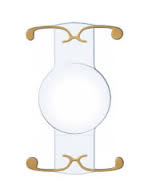
The Crystalens is an intraocular lens that is implanted during cataract surgery after the cataract has been removed. In contrast to a standard monofocal lens, the Crystalens allows patients to see both far and near in focus.
Unique to this lens is that it is essentially a monofocal lens that dynamically flexes inside the eye. The Crystalens utilizes the natural muscles within the eye to adjust its shape, and thereby, its effective power within the eye. As a result, there is range of vision that is in focus, not just two separate far and near distances.
Because the Crystalens depends on the muscles of the eye to focus between far and near, its effect can be variable, depending on the strength of the eye muscles. Although some patients can see a large range of distances in focus, the majority are only able to see two of the key distances in focus, usually from far (TV, driving) to intermediate (computers, reading newspaper). Rarely, the range is less, with the Crystalens appearing to move only minimally. The effective range is not age-dependent, and cannot be predicted before surgery.
For patients who do not achieve a full range of vision in one eye, the second eye can be targeted for a range that is offset from the first eye. For example, if the first eye can see distance to intermediate, but is somewhat weak at near, the second eye can be targeted to see intermediate to near. This results in a blended range of vision when both eyes are open, and is an elegant solution to increasing the range of good vision with the Crystalens.
The main advantage of this lens is that it does not depend on rings on the lens surface to create the far and near vision as with the Tecnis multifocal or the ReSTOR multifocal lenses. Subsequently, there is no increased risk of seeing glare, halos or starbursts around lights at night, as seen with the multifocal lenses. From a night vision perspective, lights at a distance appear as clear and as sharp as with a standard monofocal lens. Patients achieve the benefits of a range of vision in focus, without the risk of nighttime light disturbances.
Everyone’s requirements for visual function differs and so the intraocular lens selection should reflect that. When you come in for a cataract surgery consultation, we can discuss whether this lens or a different lens is best-suited for your daily lifestyle needs.